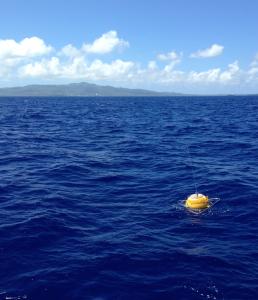PacIOOS wave buoy back online to serve Northern Mariana Island communities
University of Hawaiʻi at MānoaOn June 29, 2015, the Pacific Islands Ocean Observing System (PacIOOS) redeployed its wave buoy outside of Tanapag, Saipan. The yellow buoy is located about 5 miles offshore and will now continue to send information on ocean and wave conditions. The reinstalled buoy off Tanapag joins the existing PacIOOS network of 13 real-time wave buoys across the Pacific, providing data on wave height, direction, period, and sea surface temperature. Three of the buoys are located in the Mariana Islands.
Wave buoy data benefit the entire community and are important to make well-informed and safe decisions. Ocean users, including fishermen, commercial operators, boaters, and swimmers, can access all ocean data online, free of any charge. Real-time wave data are also vital to alert the community, emergency responders, and agency officials to big wave events that could potentially impact the shorelines of Saipan and Tinian, and even those of Rota and the Northern Islands.
“We are extremely excited that the Tanapag wave buoy is back in the water to provide real-time wave data. The buoy is a tremendous asset and a critical resource for us,” says Chip Guard from NOAA’s National Weather Service, Forecast Office in Guam. “We check the readings constantly to prepare our wave forecasts and evaluate the need for surf advisories and warnings and for small craft advisories.” Roger Edson, also of the Forecast Office, adds “It can really be helpful for flagging the largest waves during tropical storms and typhoons.”
In order to keep the buoy operational, ocean users are kindly asked to carefully navigate around the wave buoy, refrain from tying to the equipment, and avoid fishing within 100 yards to minimize entanglement in the mooring line.
Mark Merrifield, PacIOOS co-investigator and Professor of Oceanography at the University of Hawaiʻi at Mānoa, states, "The wave buoys, and the sensors that lie within, are very sensitive. Any sort of collision or other abrupt impact can damage the instruments."
Data streaming for the PacIOOS wave buoys is made possible through long-term partnerships between PacIOOS, the U.S. Army Corps of Engineers, and Coastal Data Information Program.
On the Web
Tanapag wave buoy data can be accessed at: http://pacioos.org/wavebuoy/tanapagbuoy.php
To learn more about PacIOOS: http://pacioos.org
About PacIOOS
The Pacific Islands Ocean Observing System (PacIOOS) believes that ocean data and information can help save lives and resources. In collaboration with its partners, PacIOOS aims to provide sustained ocean observations in order to support decision-making and science for stakeholders who call the Pacific Islands home. Based within the School of Ocean and Earth Science and Technology at the University of Hawai‘i at Mānoa, PacIOOS is the part of the U.S. Integrated Ocean Observing System (IOOS®).

